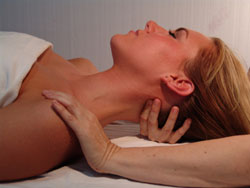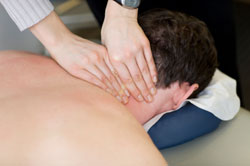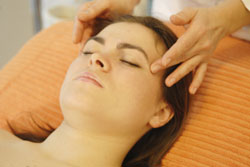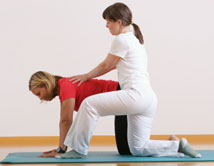|
 Services Services
Manual Physical
Therapy
Therapeutic Massage
Pelvic Floor Treatment / Women's Health / Men's Pelvic Health
What is Manual Physical Therapy?
Manual Physical Therapy
Manual PT uses one-on-one and hands-on focus giving specific attention to what your body needs to help relieve your pain. Manual physical therapy utilizes the therapist’s trained eyes and hands-on skills and techniques to assess, treat, and prevent further injury. Instead of just doing exercise routines, manual physical therapy patients receive individual attention and hands-on treatment from the therapist for the entire session. A variety of specialized techniques are used including: myofascial release, muscle-energy techniques, neuromuscular work, craniosacral therapy, stretching, strengthening and muscle re-education.
Clients are taught self-care skills so they can continue the work at home between visits. It’s important to make sure your body is balanced — much like the alignment of your car. If your car’s alignment is off you can change your tires, but they still wear out.
Manual PT directs attention to realigning the body, joints, muscles, ligaments, tendons, and connective tissue so that your body can be more efficient in every movement. This means your body will have more energy and less pain while you are living your life because manual PT can reduce wear and tear on the body, and the pain that comes with poor body alignment.
Since your time is valuable, I see clients for a one hour session once per week. We can make more progress in an effective one hour session than in multiple shorter sessions, leaving you more of your precious time for your life and family.
Call today and get started feeling better!
Top of page
Therapeutic Massage
Do you have tight muscles from stress that give you pain? Or do you just feel tight all over with no specific injury?
 Therapeutic massage can open your body up to feeling less tied down and sore. Therapeutic massage can be done for the whole body or it can have a focus such as a sore neck or shoulder. This type of massage can incorporate many techniques to decrease overall pain and tightness and promotes better movement in previously sore areas. Therapeutic massage can open your body up to feeling less tied down and sore. Therapeutic massage can be done for the whole body or it can have a focus such as a sore neck or shoulder. This type of massage can incorporate many techniques to decrease overall pain and tightness and promotes better movement in previously sore areas.
Massage is a time-honored remedy that uses the movement and pressure of the therapist’s hands to relax and release the soft tissues of the body. Also, massage can decrease heart rate and blood pressure, improve range of motion, decrease swelling, relax the mind and body, and increase endorphin levels which can decrease stress, promote relaxation and decrease pain. Again, a one hour session is provided to allow maximum time for healing of the body and mind.
Call today to set up an hour of therapeutic massage to take care of your body so you can enjoy your life.
Top of page
Pelvic Floor Treatment / Women’s Health /Men's Pelvic Health
Treatment of the pelvic floor in either females or males is a specialized aspect of physical therapy. There are a wide range of issues that can arise from tightness in the fascia or muscles of the pelvic floor or around the organs inside the pelvis. These can include urinary frequency, urgency or problems with incontinence and interstitial cystitis, and some prostate issues.
Pain in the pelvic floor region is not uncommon, such as tailbone pain/coccyxdynia, vulvodynia (pain in the vaginal area), and painful intercourse. Problems can occur from scar tissue and adhesions from either endometriosis or surgical procedures like episiotomy, laparoscopies, or hysterectomy.
Treatment of pelvic floor dysfunction is done using a combination of external and internal treatments, since pain can come from improper balance external to the pelvis or internal to the pelvis. The external treatments focus on balancing the bones of the pelvis and the fascial and muscles that pass thru the pelvic floor. Then the internal pelvic floor, fascia, muscles, and organs are treated based on the presenting symptoms to relieve the pain or imbalances found inside the pelvis.
If you suffer with pelvic floor pain or dysfunction there are many specialized treatment options available to ease your discomfort.
Top of page
What is Manual Physical Therapy?
 Manual Physical Therapy is different from conventional physical therapy that primarily uses machines or repetitive exercises. Manual physical therapy relies on the therapist's hands-on skills and techniques to assess, treat, and prevent further injury. Instead of just doing exercise routines, manual physical therapy patients receive individual attention and hands-on treatment from the therapist for the entire session. Manual Physical Therapy is different from conventional physical therapy that primarily uses machines or repetitive exercises. Manual physical therapy relies on the therapist's hands-on skills and techniques to assess, treat, and prevent further injury. Instead of just doing exercise routines, manual physical therapy patients receive individual attention and hands-on treatment from the therapist for the entire session.
The goal of manual therapy is to treat the pain and dysfunction of an injury or condition by correcting tightness and mal-alignments in joints, muscles, ligaments, and connective tissues. A variety of specialized techniques are used including:
Myofascial Release
A technique that uses a passive prolonged gentle stretch on the connective tissue layer of the body to release restrictions and/or adhesions in the fascial system to restore motion and decrease pain.
Muscle-Energy Techniques
Uses energy from gently resisted muscle contractions with the body part positioned optimally to help re-align the body structure and balance muscles in the body.
Neuromuscular Work
Uses a combination of static pressure and soft tissue mobilization to balance the musculature and nervous system as they weave between each other in the body.
 Craniosacral Therapy Craniosacral Therapy
Utilizes a very light tough to bring balance to bones, nerves, cerebral spinal fluid, and connective tissue of the craniosacral mechanism (skull, spine and tailbone).
Stretching
A therapeutic maneuver or activity done by applying a tensile force to elongate shortened tissue and increase flexibility.
Strengthening
Using focused or resisted movements to increase strength in a particular part of the body.
 Muscle Re-education Muscle Re-education
A process of determining faulty movement patterns due to imbalanced muscle recruitment and muscle firing. Then assisting the client through awareness and specific muscle movements to re-train the muscles in the correct firing and recruitment patterns to improve function and decrease pain.
Self-Care Skills
Clients are taught activities that can be performed at home in between visits to facilitate gains made during treatment sessions. Top of page |